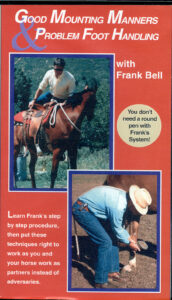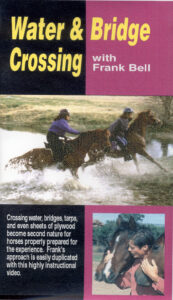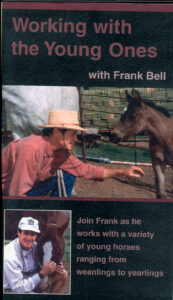Frank Bell’s natural horsemanship and horse training tips are excerpted from his acclaimed horse training videos and discussion from his natural horsemanship clinics. These horse training tips are grouped according to the video from which they were taken from. Remember: Safety First!
General Horse Training Tips
- Pay close attention to your horse’s diet. Hotter blooded horses require less protein. If overfed they can become too “high.”
- Teach your horses to lead properly. There is a bubble around you they cannot invade -unless invited.
- Don’t turn your horses into beggars and muggers with treats. Feed from a bucket, not your hand.
- Learn how to properly reprimand your horse, if necessary. Beginning with a shhhhhhhh noise lets the horse know he’s getting out of bounds.
- Learn Frank Bell’s ‘ballet on the ground’ and in the saddle, as safety becomes an artful dance
Horse Training DVD’s by Frank Bell download on-demand 19.99
Discover The Horse You Never Knew
Discover The Horse You Never Knew! Frank Bell’s Foundation Video. . . The Place To Start!
- A properly executed one rein stop can prevent run-aways, bucking, rearing, balking, and undesired backing.
- Desensitizing your horse never ends. How creative are you?
- A horse that drives well will be easier to load into a trailer.
- Helping a horse overcome fear instills heightened horse/rider confidence.
- Head high = uptight horse, Head low = relaxed horse. Teach your horse to drop his head!
- A horse working his mouth, licking his lips, is a sign of understanding and relaxation.
- Horses enjoy having their eyes, ears, nose, and mouth massaged.
- A well-prepared horse will invite you to go riding. Watch for the invitation.
- Get a feel for the word feel.
- Learn Frank Bell’s 7-Step Safety System well. You’ll take 80% of the risk out of riding, have heightened confidence and safety. Safety is everything!
- Download DVD Now
Communication in the Saddle with Frank Bell
Clear, concise communication begins in the mind, then moves through the rider’s body.
Learn how to tell the horse exactly what you want and don’t want. Learn how to control
your horse using only leg and seat pressure. Riding with life, V-thinking, the black and
white zones that communicate right from wrong, total focus, half-passing, and side-
passing, soft feel, proper backing, mounting from a block or the fence and transitions are
clearly demonstrated and explained. Your riding will take a quantum leap with this video.
- When you and your horse are really together, your wishes will transfer from your mind to your horse’s mind.
- Your reins may be the last thing you use to stop or steer your horse.
- Don’t kick your horse. Tell him to go with your body language.
- Point your belly button in the direction you want to go.
- Think ‘less is more’ all the time and you’ll get there.
- Never use the bit to balance yourself.
- You should be able to stand out of the saddle at any and all times without a lunge forward or pulling on mane or bit to raise yourself. Balance.
- Have a slide show of just what you want in your mind as you work with your horses.
- Understand Frank Bell’s 3-Ts of communication. A full understanding of the Theory must come first. Why are you doing what you are doing? Next learn the specific Technique to convey your wishes to the horse. Improve your Timing.
- The horse learns from the release of pressure. Timing is critical.
- Always quit your session on a good note, even if it means doing something very simple.
- Smile a lot. Remember, this is about recreation.
- Download Now
- https://vimeo.com/ondemand/communicationsaddle
Spooking/Shying
- Spooky horses lack confidence and experience.
- Your confidence travels right through your body into your horse’s. Build your own confidence and you’ll build your horse’s as well!
- Your horse’s greatest fear can become your greatest asset.
- Your calm, confident horse can help settle your spooky one.
- Change your horse’s mind when on the verge of ‘melting down’, like a child on the verge of a tantrum. Pull the horse’s mind away from that problem by distracting in the opposite direction.
- You can support your horse through much more than you realize. Always begin your de-spooking on the ground first. Understand Frank Bell’s 3-T’s of communication: Theory, Technique, Timing. (Explained above).
- download DVD!
- https://vimeo.com/ondemand/spookingandshying
Trailer Loading
- A well-lit trailer, sun or artificial light can aid in loading. A dark trailer is scary, especially the first time.
- With a new trailer, add some horse smells i.e. manure, hay, tack, blankets etc.
- Adequate headroom is of utmost importance. Be fair. Measure the horse and trailer before purchasing the wrong one.
- Drive your horse over stacked railroad ties to teach to step-up into the trailer.
- One foot solidly on a loading ramp leads to a loaded horse, with patience.
- Better to load a horse part way the first time than all the way in. Use “baby steps”.
- Once loaded, be certain the horse understands he can move his feet.
- A horse well prepared to load will save hours, headaches, and vet bills in the future, let alone embarrassment.
- Do a solid assessment of your trailer’s danger zones. Sharp objects, hoof catchers, etc.
- Be careful where you tie your horse to the trailer. Are there any sharp objects nearby?
- Always double check all your hook-ups, mechanical, electrical, and tires before departing. You cannot be too careful.
- Take a moment to think carefully before unloading a horse. I prefer this sequence for unloading- butt bar, untie lead, open door. If the door is opened before untying the horse, some horse will try to back out and freak out when they feel tied in.
- Ride in the back of the trailer to see/feel what the horse experiences.
- Tap the brake lightly before a stop or turn. This allows the horse to prepare.
- It never hurts to have the horses’ favorite food in the trailer when they load up.
- Slant loads stress horses less than straight loads. It’s the way they balance naturally in an open stock trailer.
- Be able to lead or drive your horse into the trailer. It’s much safer to drive the horse in. (Keeps your Sunday shoes cleaner as well.)
- Download DVD Now
- https://vimeo.com/ondemand/trailerloading2
Solving 7 Common Horse Problems
- There are two types of problems. One is caused by fear or ignorance. The second is a willful act of defiance. The first must be addressed using patience and empathy. Feel the horse’s fear and help him through it lovingly. The willful horse must bump right into the brick wall the very moment he begins his defiance. Set it up for his bad behavior to be uncomfortable. Learn how to appropriately reprimand a horse.
- There are times you’ll never catch a horse that has decided not to be caught. Don’t act like the predator that you are. Use soft, non-threatening eyes when approaching.
- Pull-back horses usually don’t lead well.
- While a horse is eating he is less afraid of ear handling, spray, and clippers. Helping him work his mouth, using food in really bothered situations, can be helpful and fast.
- Before asking for a foot, ask the horse to prepare to give it. He should have all four feet on the ground.
- Only release the foot when you are ready and place exactly where you want it.
- A dollop of molasses on a bit makes it a more pleasant experience, especially for hard to bit or first time horses.
- On a cold day a bit warmed up in your armpit shows you care.
- If a horse is fed and made comfortable right after each ride, where will he or she prefer to be?
- Make being away from the barn a fun, educational adventure.
- Give your horse a good foot massage prior to trimming or shoeing.
- https://vimeo.com/ondemand/commonproblemshorses
- Download now
Mounting the Difficult Horse
Problem Foot Handling
- Always mount and dismount with mane and rein in hand.
- Teach your horse to accept being mounted from either side. You may have to dismount on a hill someday.
- Teach your horse to accept being mounted from a block, stump, fence or anywhere.
- You should have only your toe in the stirrup when mounting and dismounting.
- Make it uncomfortable for your horse to walk-off when mounting. Make it very comfortable to stand perfectly still.
- Never allow your horse to walk off when mounted until you are ready. Who is in charge here?
- Rock in the saddle prior to dismounting. It lets the horse know it’s coming.
- A horse’s right rear foot is the farthest point from his brain. Run your hand under the horse’s tail prior to asking for a back leg. Then run your hand all the way down the horse’s leg prior to asking. A soft tail usually signifies a cooperative horse.
- Only release the hind foot when the horse is totally relaxed and will allow you to set it down with no weight on it.
- Give your horse a good foot massage prior to trimming or shoeing or just because you like him and he’d appreciate it.
- https://vimeo.com/ondemand/mounting
- https://vimeo.com/576262361
Retraining the Racehorse
- Most racehorses have had little foundation work.
- Assume there has been little or inadequate training and start from the beginning.
- Your hand in the air translates into pain for most racehorses. They were whipped to win and lose alike. Help them get over this.
- Many racehorses have drugs in their systems that can take months to dissipate.
- Large groups of horses, loud speakers, flags, etc. all mean go fast to the ex-racehorse. Help them learn to tolerate these distractions intelligently. Don’t overload the horse.
- Racehorses can be brought back to become magnificent well-adjusted, happy creatures with patience and empathy.
- Three to six month turn-out does wonders for horses just off the track.
- Be certain the ex-racehorse has plenty of room to move and play and be a horse. Don’t keep your horses locked up in cells (stalls).
- Assess the food issue. Too much hot foot (high protein) can slow progress. Consider beet pulp to keep weight on those wired Arabs and Thoroughbreds.
- Long quiet rides with other quiet horses does wonders for racehorses. Don’t ride with fidgety, nervous horses, especially in the beginning.
- https://vimeo.com/ondemand/retrainingtheracehorse
- Download DVD Now!
Water and Bridge Crossing
- Mustangs don’t fear water, but have little bridge experience.
- Horses that leap over small creeks are very dangerous. Fix it! Make your horse go slowly, step-by-baby-step.
- Horses comfortable with water will roll and play in it and enjoy a bath, especially on a hot day.
- Give your horse a bath on a hot day in an indentation. By the time it’s over the horse is standing in a puddle. Then lead and drive the horse through the puddle.
- Teach your horse to walk over a folded tarp quietly. Unwrap the tarp one fold, then lead and drive again, etc. Stay with it until the horse can quietly walk across an entire tarp. This will make crossing water much easier.
- Loud hoof sounds on a bridge are more frightening than the bridge. Teach your horse to deal with the sounds well before you approach the challenge, by leading and driving the horse across plywood. Make it a fun game.
- When crossing a bridge, focus on the other side and ride straight to it with energy. Don’t look over the side.
- Helping your horse enjoy water will do wonders for everyone’s confidence.
- https://vimeo.com/ondemand/waterandbridgecrossing
- Download DVD now
Starting the Young Horse
- Wear a helmet!
- A well-prepared horse (fully understanding Frank Bell’s 7 Steps) is already on the 90 yard line when it’s time to ride. Teach your young horse go, whoa, back, and to plow rein before mounting.
- Drive the horse in a circle with lariat tied to horn. Pull hard to prepare horse for saddle movement and binding of the girth. Then run lariat through stirrup to horn and flap stirrups as horse learns to move quietly.
- Drive horse through his transitions in round pen while saddled. Watch for smooth transitions, soft eyes, ears, and tail set.
- Leaning over a horse from a fence or hay bale will prepare that horse for seeing you overhead, and then in the saddle, which can be a shock.
- Depending on age and size of your horse, keep those first rides short and fun.
- Always leave each session on a good note even if it means doing something very simple. It’s a win for you and your horse.
- Lavish praise speeds up the learning process by 60%!
- Remember, the long way is the short way. (Thanks Tom.)
- Always perform Frank Bell’s 7 Steps prior to riding this or any horse. Your safety is of highest importance.
- https://vimeo.com/ondemand/startingtheyounghorse
- download DVD Now
Working With Young Horses
- You can’t begin working with a horse too early in life, but be sensitive. Expose the youngster to all kinds of stimuli. It’s all part of life.
- The younger the horse, the shorter the session.
- Read the youngster’s attitude and keep the session fun and interesting.
- More short sessions per day are better than longer ones.
- A simple piece of baling twine is a very useful tool for teaching pressure and release and beginning foot handling.
- Keep young horses close to their mamas. This helps them stay calm during the short training sessions.
- Help your horse enjoy your hands all over their bodies. Explore for what they like and don’t like. Help them through their difficult, distrusting places.
- Don’t create beggars and muggers with treats.
- Teach them all Frank Bell’s 7-Step Safety System early. The rest of their lives will be a snap.
- https://vimeo.com/ondemand/workingwiththeyoungones
- Download DVD Now!